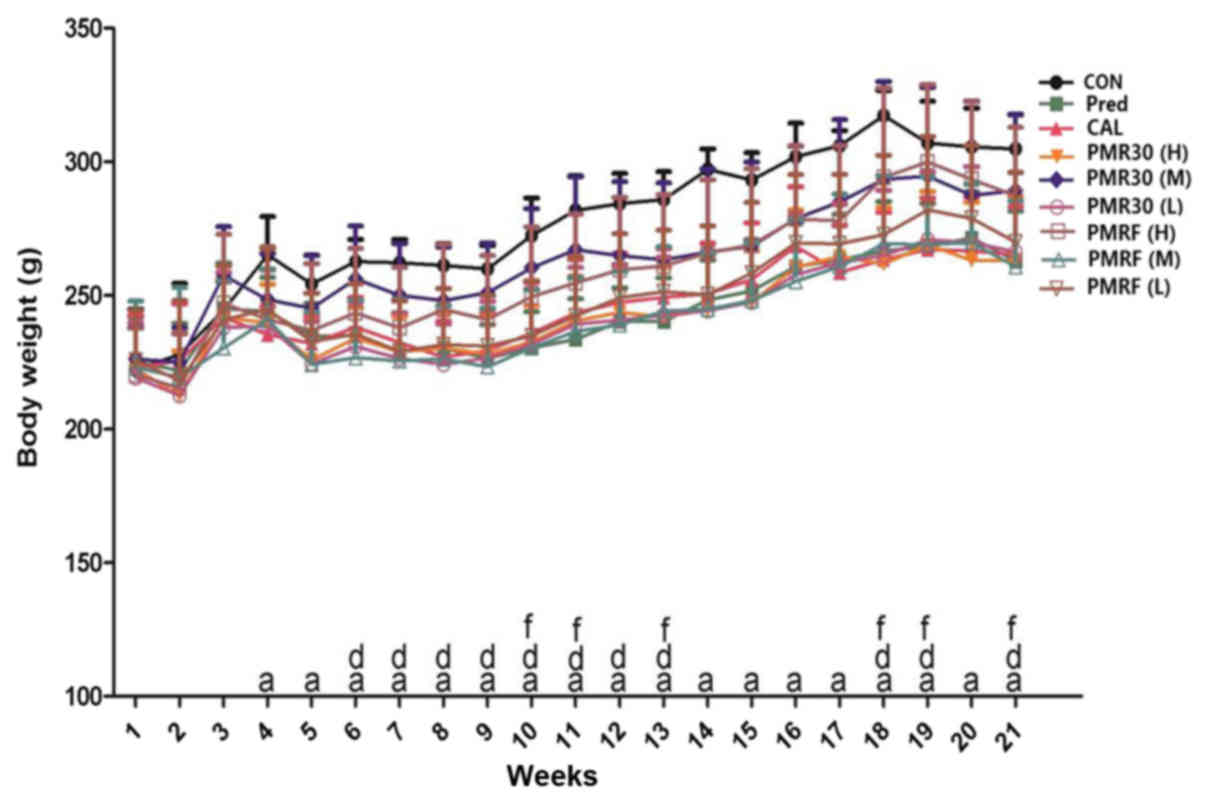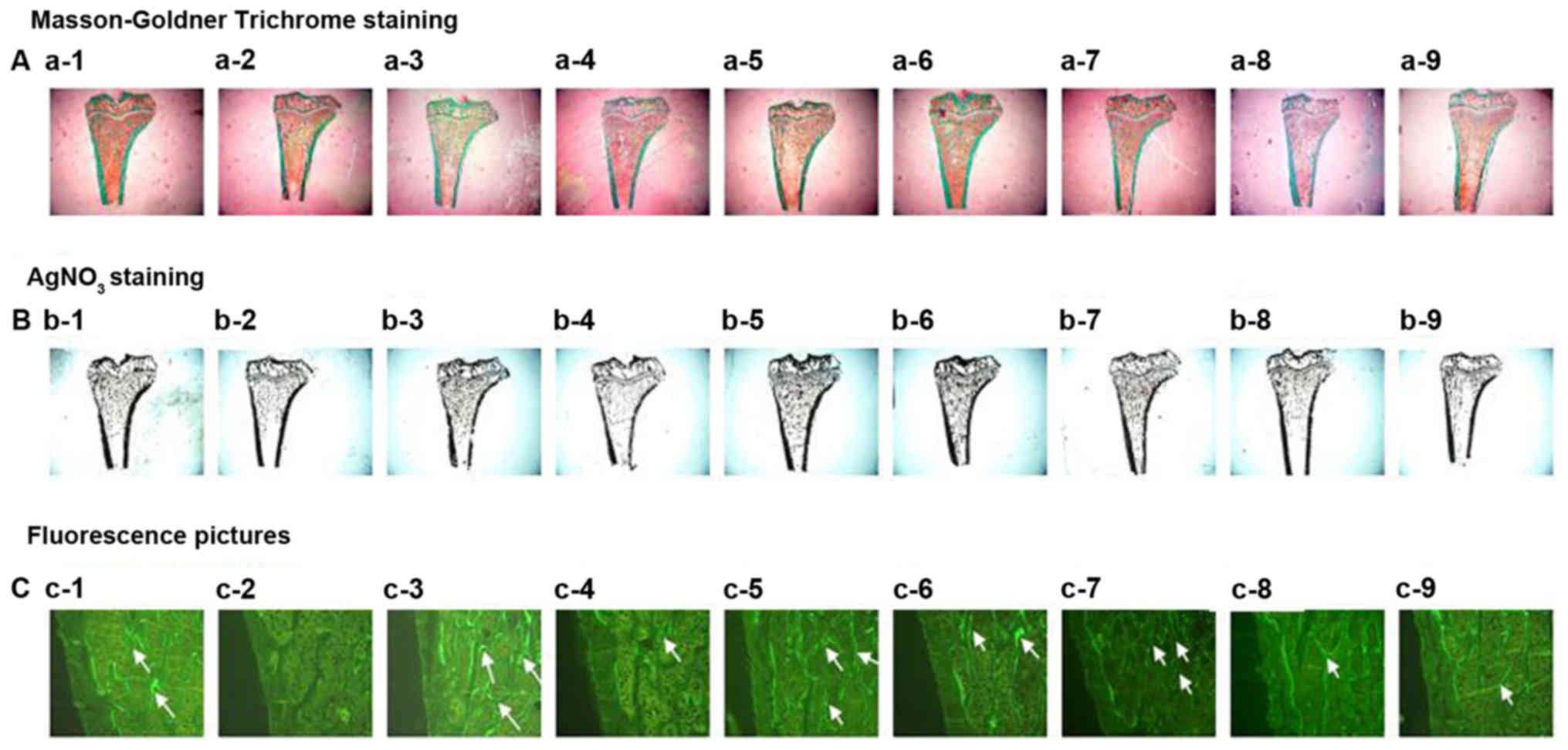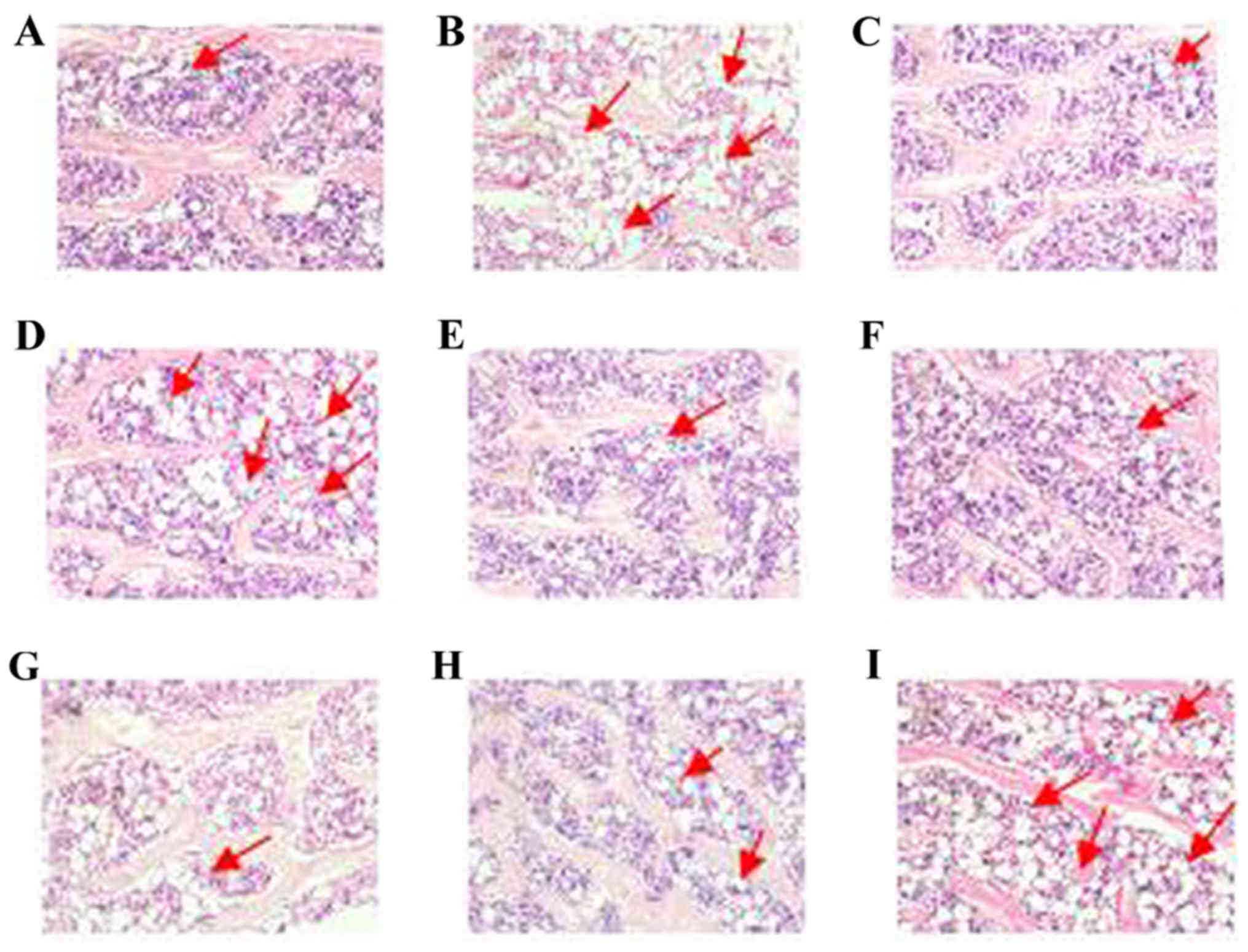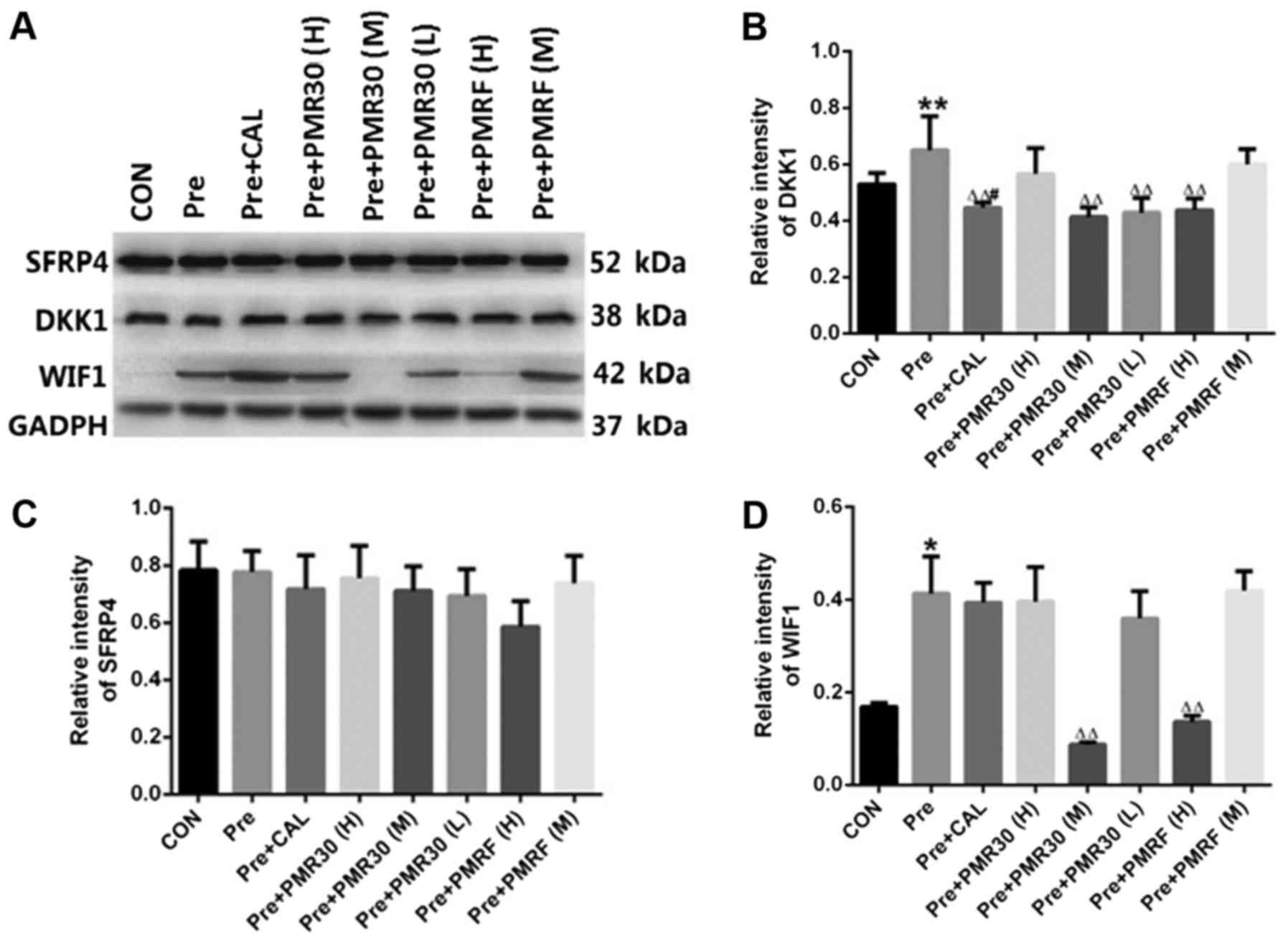|
1
|
McLaughlin F, Mackintosh J, Hayes BP,
McLaren A, Uings IJ, Salmon P, Humphreys J, Meldrum E and Farrow
SN: Glucocorticoid-induced osteopenia in the mouse as assessed by
histomorphometry, microcomputed tomography, and biochemical
markers. Bone. 30:924–930. 2002. View Article : Google Scholar : PubMed/NCBI
|
|
2
|
Ogoshi T, Hagino H, Fukata S, Tanishima S,
Okano T and Teshima R: Influence of glucocorticoid on bone in 3-,
6- and 12-month-old rats as determined by bone mass and
histomorphometry. Mod Rheumatol. 18:552–561. 2008. View Article : Google Scholar : PubMed/NCBI
|
|
3
|
Buttgereit F, Burmester GR and Lipworth
BJ: Optimised glucocorticoid therapy: The sharpening of an old
spear. Lancet. 365:801–803. 2005. View Article : Google Scholar : PubMed/NCBI
|
|
4
|
den Uyl D, Bultink IE and Lems WF:
Advances in glucocorticoid-induced osteoporosis. Curr Rheumatol
Rep. 13:233–240. 2011. View Article : Google Scholar : PubMed/NCBI
|
|
5
|
Schäcke H, Döcke WD and Asadullah K:
Mechanisms involved in the side effects of glucocorticoids.
Pharmacol Ther. 96:23–43. 2002. View Article : Google Scholar : PubMed/NCBI
|
|
6
|
Humphrey EL, Williams JHH, Davie MW and
Marshall MJ: Effects of dissociated glucocorticoids on OPG and
RANKL in osteoblastic cells. Bone. 38:652–661. 2006. View Article : Google Scholar : PubMed/NCBI
|
|
7
|
Saag KG: Low-dose corticosteroid therapy
in rheumatoid arthritis: Balancing the evidence. Amat J Med.
103:31S–39S. 1997. View Article : Google Scholar
|
|
8
|
Adachi JD, Bensen WG and Cividino A:
Corticosteroid induced osteoporosis. J Am Med Womens Assoc (1972).
53(25–30): 401998.
|
|
9
|
Chen ZG, Xue JQ, She T, Mu SA and Fu Q:
Curcumin alleviates glucocorticoid-induced osteoporosis through the
regulation of the Wnt signaling pathway. Int J Mol Med. 37:329–338.
2016. View Article : Google Scholar : PubMed/NCBI
|
|
10
|
Ling S and Xu JW: Biological activities of
2,3,5,4′-tetrahydroxystilbene-2-O-β-D-glucoside in antiaging and
antiaging-related disease treatments. Oxid Med Cell Longev.
2016:49732392016. View Article : Google Scholar : PubMed/NCBI
|
|
11
|
Yao W, Gu C, Shao H, Meng G, Wang H, Jing
X and Zhang W: Tetrahydroxystilbene glucoside improves
TNF-α-induced endothelial dysfunction: Involvement of TGFβ/Smad
pathway and inhibition of vimentin expression. Am J Chin Med.
43:183–198. 2015. View Article : Google Scholar : PubMed/NCBI
|
|
12
|
Chan YC, Cheng FC and Wang MF: Beneficial
effects of different Polygonum multiflorum Thunb. Extracts on
memory and hippocampus morphology. J Nutr Sci Vitaminol (Tokyo).
48:491–497. 2002. View Article : Google Scholar : PubMed/NCBI
|
|
13
|
Chan YC, Wang MF and Chang HC: Polygonum
multiflorum extracts improve cognitive performance in senescence
accelerated mice. Am J Chin Med. 31:171–179. 2003. View Article : Google Scholar : PubMed/NCBI
|
|
14
|
Liu QL, Xiao JH, Ma R, Ban Y and Wang JL:
Effect of 2,3,5,4′-tetrahydroxystilbene-2-O-beta-D-glucoside on
lipoprotein oxidation and proliferation of coronary arterial smooth
cells. J Asian Nat Prod Res. 9:689–697. 2007. View Article : Google Scholar : PubMed/NCBI
|
|
15
|
Um MY, Choi WH, Aan JY, Kim SR and Ha TY:
Protective effect of Polygonum multiflorum Thunb on amyloid
beta-peptide 25–35 induced cognitive deficits in mice. J
Ethnopharmacol. 104:144–148. 2006. View Article : Google Scholar : PubMed/NCBI
|
|
16
|
Yang PY, Almofti MR, Lu L, Kang H, Zhang
J, Li TJ, Rui YC, Sun LN and Chen WS: Reduction of atherosclerosis
in cholesterol-fed rabbits and decrease of expressions of
intracellular adhesion molecule-1 and vascular endothelial growth
factor in foam cells by a watersoluble fraction of Polygonum
multiflorum. J Pharmacol. 99:294–300. 2005.
|
|
17
|
Huang LF, Wu T, Xie H and Liao JM: The
prevention and treatment on bone loss in ovariectomized rats of
Polygonum decoction. Chinese J Gerontology. 25:709–710. 2005.(In
Chinese).
|
|
18
|
Liu YY, Cui L, Wu T and Yao WM: Effects of
emodin on the proliferation and differentiation of osteoblast
isolated from neonatal rat calvarium in vitro. Chin Pharmacol Bull.
21:235–240. 2005.(In Chinese).
|
|
19
|
Liu YY, Cui L, Wu T and Yao WM: Effects of
emodin on adipogenesis of marrow stromal cells in vitro. Chin
Pharmacol Bull. 21:842–846. 2005.(In Chinese).
|
|
20
|
Liu YY, Yao WM, Ai CM and Xu BL: Effects
of emodin on differentiation of bone marrow stroma cell into
osteoblast in rats in vitro. Chin J Clin Pharmacol Ther.
10:191–195. 2005.(In Chinese).
|
|
21
|
Liu YY, Yao WM, Ai CM and Xu BL: Effects
of emodin on osteoblast in vitro. Chin Pharmacol Bull.
21:1473–1477. 2005.(In Chinese).
|
|
22
|
Zheng YY: Seperation and purification of
the Polygonum multiflorum extract and its effect on
anti-osteoporosis. Guangdong Med Univ. 2014.(In Chinese).
|
|
23
|
Ohnaka K, Tanabe M, Kawate H, Nawata H and
Takayanagi R: Glucocorticoid suppresses the canonical Wnt signal in
cultured human osteoblasts. Biochem Biophys Res Commun.
329:177–181. 2005. View Article : Google Scholar : PubMed/NCBI
|
|
24
|
Kawano Y and Kypta R: Secreted antagonists
of the Wnt signaling pathway. J Cell. 116:2627–2634. 2003.
|
|
25
|
Ohnaka K, Taniguchi H, Kawate H, Nawata H
and Takayanagi R: Glucocorticoid enhances the expression of
dickkopf-1 in human osteoblasts: Novel mechanism of
glucocorticoid-induced osteoporosis. Biochem Biophys Res Commun.
318:259–264. 2004. View Article : Google Scholar : PubMed/NCBI
|
|
26
|
Song L, Liu M, Ono N, Bringhurst FR,
Kronenberg HM and Guo J: Loss of wnt/β-catenin signaling causes
cell fate shift of preosteoblasts from osteoblasts to adipocytes. J
Bone Miner Res. 27:2344–2358. 2012. View Article : Google Scholar : PubMed/NCBI
|
|
27
|
Zhou MR, Li J, Wu JK, Zeng XB, Chen JF,
Cui L and Liu YY: The preventive effect of Polygonum multiflorum on
the changes of micro-structural and biomechanical by prednisone.
Chin Pharmacol Bull. 31:1273–1279. 2015.(In Chinese).
|
|
28
|
Zhou MR, Li J, Wu JK, Yang YJ, Zeng XB, Lv
XH, Cui L, Yao WM and Liu YY: Preventive effects of Polygonum
multiflorum on glucocorticoid induced osteoporosis in rats. Exp
Ther Med. 14:2445–2460. 2017.PubMed/NCBI
|
|
29
|
Liu YZ, Cui Y, Chen Y, Gao X, Su YJ and
Cui L: Effects of dexamethasone, celecoxib, and methotrexate on the
histology and metabolism of bone tissue in healthy sprague Dawley
rats. Clin Interv Aging. 10:1245–1253. 2015. View Article : Google Scholar : PubMed/NCBI
|
|
30
|
Lin S, Huang J, Zheng L, Liu Y, Liu G, Li
N, Wang K, Zou L, Wu T, Qin L, et al: Glucocorticoid-Induced
Osteoporosis in Growing Rats. Calcif Tissue Int. 95:362–373. 2014.
View Article : Google Scholar : PubMed/NCBI
|
|
31
|
Yang Y, Su Y, Wang D, Chen Y, Liu Y, Luo
S, Wu T and Cui L: Tanshinol rescues the impaired bone formation
elicited by glucocorticoid involved in KLF15 pathway. Oxid Med Cell
Longev. 2016:10927462016. View Article : Google Scholar : PubMed/NCBI
|
|
32
|
Cui L, Li T, Liu Y, Zhou L, Li P, Xu B,
Huang L, Chen Y, Liu Y, Tian X, et al: Salvianolic acid B prevents
bone loss in prednisone-treated rats through stimulation of
osteogenesis and bone marrow angiogenesis. PLoS One. 7:e346472012.
View Article : Google Scholar : PubMed/NCBI
|
|
33
|
Wu Q, Xiong X, Zhang X, Lu J, Zhang X,
Chen W, Wu T, Cui L, Liu Y and Xu B: Secondary osteoporosis in
collagen-induced arthritis rats. J Bone Miner Metab. 34:500–516.
2016. View Article : Google Scholar : PubMed/NCBI
|
|
34
|
Dong F and Ren J: Insulin-like growth
factors (IGFs) and IGF-binding proteins in nephrotic syndrome
children on glucocorticoid. Pharmacol Res. 48:319–323. 2003.
View Article : Google Scholar : PubMed/NCBI
|
|
35
|
Sasaki N, Kusano E, Takahashi H, Ando Y,
Yano K, Tsuda E and Asano Y: Vitamin K2 inhibits
glucocorticoid-induced bone loss partly by preventing the reduction
of osteoprotegerin (OPG). J Bone Miner Metab. 23:41–47. 2005.
View Article : Google Scholar : PubMed/NCBI
|
|
36
|
Tang SJ, Meikle MC, MacLaine JK, Wong RW
and Rabie BM: Altered serum levels of the osteoclast-specific TRACP
5b isoform in Chinese children undergoing orthodontic treatment.
Eur J Orthod. 35:169–174. 2013. View Article : Google Scholar : PubMed/NCBI
|
|
37
|
Cui L, Liu YY, Wu T, Ai CM and Chen HQ:
Osteogenic effects of D+beta-3, 4-dihydroxyphenyl lactic acid
(salvianic acid A, SAA) on osteoblasts and bone marrow stromal
cells of intact and prednisone-treated rats. Acta Pharmacol Sin.
30:321–332. 2009. View Article : Google Scholar : PubMed/NCBI
|
|
38
|
Lo YH, Chen YJ, Chung TY, Lin NH, Chen WY,
Chen CY, Lee MR, Chou CC and Tzen JT: Emoghrelin, a unique emodin
derivative in Heshouwu, stimulates growth hormone secretion via
activation of the ghrelin receptor. J Ethnopharmacol. 159:1–8.
2015. View Article : Google Scholar : PubMed/NCBI
|
|
39
|
Kim HJ, Zhao H, Kitaura H, Bhattacharyya
S, Brewer JA, Muglia LJ, Ross FP and Teitelbaum SL: Glucocorticoids
suppress bone formation via the osteoclast. J Clin Invest.
116:2152–2160. 2006. View Article : Google Scholar : PubMed/NCBI
|
|
40
|
Ehrlich PJ and Lanyon LE: Mechanical
strain and bone cell function: A review. Osteoporos Int.
13:688–700. 2002. View Article : Google Scholar : PubMed/NCBI
|
|
41
|
Bafico A, Liu G, Yaniv A, Gazit A and
Aaronson SA: Novel mechanism of Wnt signalling inhibition mediated
by Dickkopf-1 interaction with LRP6/Arrow. Nat Cell Biol.
3:683–686. 2001. View Article : Google Scholar : PubMed/NCBI
|
|
42
|
Rossini M, Gatti D and Adami S:
Involvement of WNT/β-catenin signaling in the treatment of
osteoporosis. Calcif Tissue Int. 93:121–132. 2013. View Article : Google Scholar : PubMed/NCBI
|




















